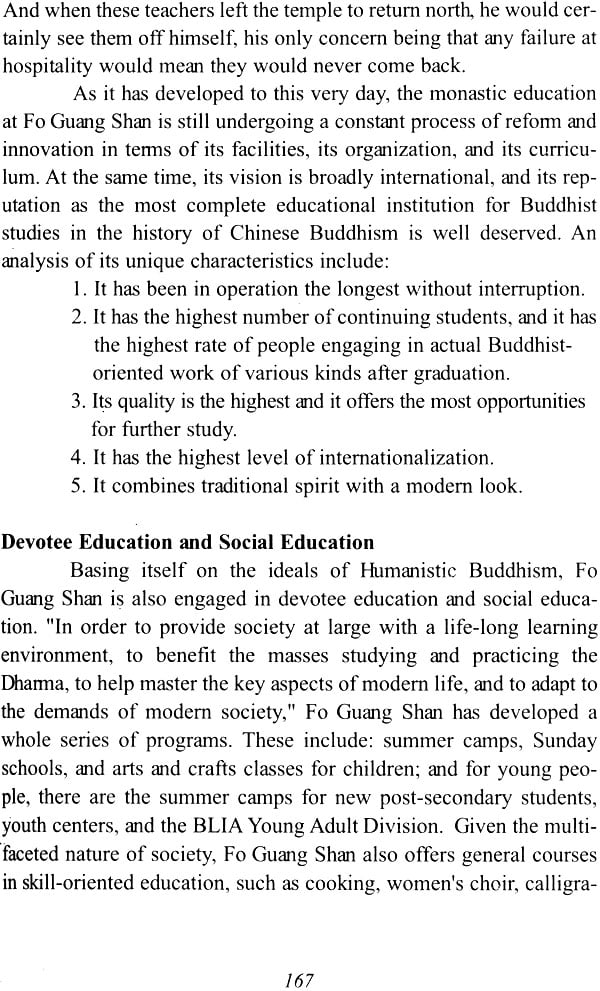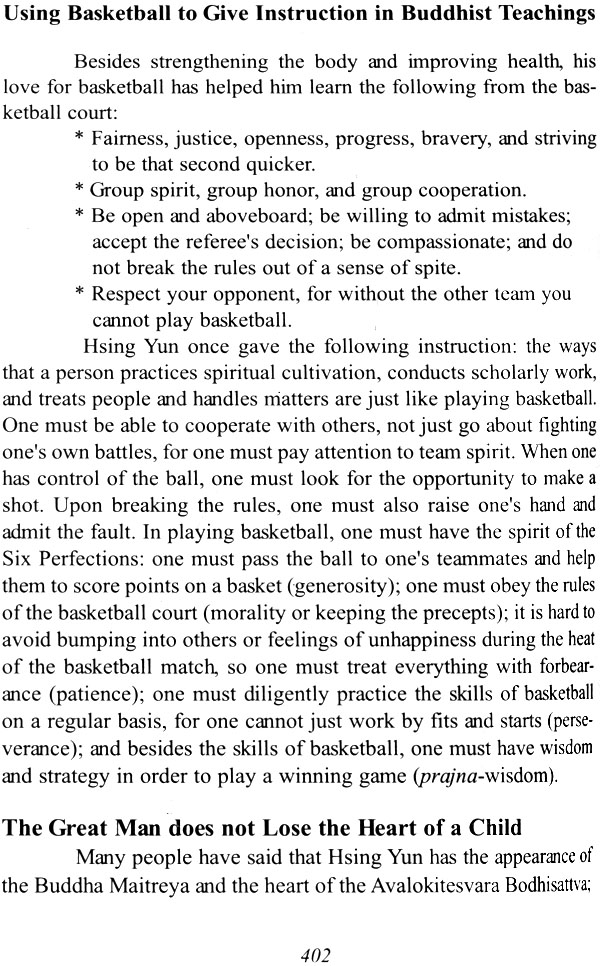
Bright Star Luminous Cloud (The Life a Simple Monk)
Book Specification
| Item Code: | NAJ873 |
| Author: | Robert H. Smitheram |
| Publisher: | Buddha Light Art and Living Pvt Ltd |
| Language: | English |
| Edition: | 2012 |
| ISBN: | 9789382017011 |
| Pages: | 507 (20 Color Illustrations) |
| Cover: | Paperback |
| Other Details | 8.5 inch X 5.5 inch |
| Weight | 550 gm |
Book Description
This is the life story of Venerable Master Hsing Yun, who has dedicated his life to the modernization and globalization of Buddhism through the building of temples, educational institutions, libraries, art galleries and museums throughout the world A strong supporter of interfaith respect and cooperation he has participated in many interfaith events, conducted Dharma Services, and lectured on Buddhism in countries around the globe.
Preface
A Forerunner in the "Blue Ocean Strategy,"
The Pioneer in "Humanistic Buddhism"
I. "Strategy" and "Model"
It was twelve years ago that the first biography of the Venerable Master Hsing Yun, Handing Down the Light, appeared in print, an event which set a magnificent record for the publishing world. That story of Hsing Yun’s teaching the Dharma for the benefit of human beings as told by Fu Zhiying warned the hearts of millions of readers at home and abroad.
This year marks the 40th anniversary of Fo Guang Shan’s founding, as well as the Venerable Master’s own 80th birthday, and so Fu Zhiying has exerted her writing skills once more to author Bright Star, Luminous Cloud: Life of a Simple Monk, a book which records the Venerable Master’s lifetime mission both in terms of the broadness of its vision and the exactness of its details.
This biography thus represents an even more moving and continued record of the "Four Great Objectives" as promoted by the Venerable Master Hsing Yun since the earliest beginnings of Fo Guang Shan: to propagate the Dharma through culture, to foster talent through education, to benefit society through charity, and to purify the human mind through cultivation. As my academic background lies in the field of economics and management, I would like to pose a question in terms with which I am familiar: What "economic strategy" and what "business model" has the Venerable Master Hsing Yun employed in creating these globe-spanning "business ventures" as a part of Fo Guang Shan and the Buddha’s Light International Association (BLIA)?
More specifically, I would ask:
* How was Hsing Yun able to transform the ideas of Buddhism into principles that everyone could approach?
* How was Hsing Yun then able to transform these principles into a specific model to be followed?
* How was Hsing Yun further able to manage such a huge organization with such consummate order?
* Then again, how was Hsing Yun able to accomplish Fo Guang Shan’s generational succession, turning over his abbot’s position to his successor at the age of fifty-eight? And furthermore, how was he able to create an even greater, open space for Buddhism even after he had relinquished his office?
* Finally, how was Hsing Yun also’ able to apply the power of his aspirations, his spiritual connections, and his virtuous conduct, to seemingly "out of nothing" have Buddhism radiate outwards from just one spot, one place, and one country, and spread around the globe?
II. The Blue Ocean Strategy of Value Innovation
The books Blue Ocean Strategy and Humanistic Buddhism in the Style of Hsing Yun, published by Commonwealth Publishing Company in August of last year, supply the key answer, and their publication immediately garnered the attention and affirmation of various groups in society.
The "blue ocean" in the title of the first book is not a political slogan, but rather a metaphor for the sense of limitless opportunity, suggesting the vastness that stretches from horizon to horizon of the blue oceans. It is just such a place that awaits the appearance of ambitious seafarers who seek their fortunes on the open sea.
As the book Blue Ocean Strategy points out, no enterprise can maintain its dominance forever, but there is a strategy that can defeat this fate by "going beyond the red sea of bloody competition and the zero-sum game to create an uncontested market space and exploit the business opportunities of the blue ocean."
Thus, the "blue ocean strategy" essentially means a break from the malignant nature of traditional competition by stimulating the enterprise (or organization) to seek out a totally new imaginative space and direction for development. Enterprises should no longer stick to one set market, nor fight from a besieged stronghold, much less keep a stranglehold on its old markets and old products; rather, enterprises should courageously establish alternative areas of operation, seeking out other markets and other life giving resources. It is here in these newly created environments attained through value innovation that enterprises can truly demonstrate their unique qualities. In formulating a "blue ocean strategy," one must employ the "four actions framework": (1) Which factors that are considered customary by others in the field can be "eliminated"? (2) Which factors that are unnecessary can be "reduced"? (3) Which factors can be "raised" above the standard of others in the field? And (4) Which factors can be "created" that are not offered by others in the same field? (1) and (2) economize on cost and expand demand; while (3) and (4) emphasize "differentiation" and "new value" as a way of increasing one’s value.
In fact, Humanistic Buddhism has expanded by quietly employing these "blue ocean" strategies over a long period of time. With Hsing Yun personally setting the example, Fo Guang Shan has:
* always endeavored to develop "new markets" in the are, of religion;
* not competed with other religions, making the issue of "competition" irrelevant;
* created a new demand for its followers and society seeking to maintain its leading position;
* simultaneously kept both the faith of its followers and the trust of society;
* standardized its training of personnel and its operational system.
Introduction
This biography of Venerable Master Hsing Yun, originally written in Chinese by Fu Chi-Ying and translated into English by Robert H. Smitheram Ph. D., will be of great interest to anyone interested in learning about the Buddha, his teachings and how they are relevant to today’s society. You can learn about the Buddha by reading about the influence of the Buddha in the Master’s life; you can learn about the Buddha’s teachings by observing how they are lived out in the life of Venerable Master Hsing Yun and you can learn their significance to today’s society by seeing how Venerable Master Hsing Yun has applied them in his work of teaching the Dharma to the world.
As he moved from novice to fully ordained monk Venerable Master Hsing Yun never stopped being a simple monk who wanted to share the Dharma. He began to focus on the modernization and expansion of Buddhism with the objective of taking Buddhism from the mountain top back into the city and from the monasteries back into large and small temples throughout Taiwan that would be frequented by busy people going about earning a daily living.
He started with a small, ill-kept temple in Ilan, in Northern Taiwan, and later built Fo Guang Shan, a huge, beautiful, efficiently run and exquisitely maintained monastery in Kaohsiung, in the Southern part of Taiwan. Fo Guang Shan is the hub of the Venerable Master’s Dharma wheel from which has grown temples on all five continents, where all are welcomed to share in the Dharma joy that the Master and his disciples so abundantly provide.
In keeping with his philosophy of Humanistic Buddhism, Venerable Master Hsing Yun’s temples are built to be more than places where one goes to pay homage to the Buddhas. He believes that temples should contain libraries, art galleries, museums, dining halls, information centers and conference rooms. His temples are offerings to the communities in which they are located as well as offerings to all the Buddhas and bodhisattvas.
Visit any of the temples founded by Venerable Master Hsing Yun in Asia, Africa, Europe, North America, or South America and devotees and disciples of Venerable Master Hsing Yun will welcome you with the greatest of respect, which is how the Venerable Master himself would welcome you.
CONTENTS
| Chapter One | "A Rare Moment in Time" | 1 |
| Chapter Two | A Little Seed of Buddhahood Descends into the Human World | 14 |
| Chapter Three | Leaving the Family to Enter Qixia | 31 |
| Chapter Four | Taking on Responsibility for Buddhism’s Rise or Fall | 42 |
| Chapter Five | Taiwan-- This Land and This Person | 53 |
| Chapter Six | Ilan, the Source of It All | 63 |
| Chapter Seven | A Modem and Creative Buddhism | 74 |
| Chapter Eight | A Magnificent Pure Land for Humanity | 104 |
| Chapter Nine | Propagating the Dharma in a Myriad of Countries | 134 |
| Chapter Ten | The Four Great Objectives -- Wisdom Forever Burning Bright | 158 |
| Chapter Eleven | Collective Creation, Systematic Leadership | 183 |
| Chapter Twelve | Dharma will Light the Torch | 206 |
| Chapter Thirteen | Not Rejecting a Single Living Being | 235 |
| Chapter Fourteen | Grand Assembly of Buddha’s Light Members on Spirit Mountain | 246 |
| Chapter Fifteen | One Dharma Lineage Nurtures Both Sides of the Straits | 266 |
| Chapter Sixteen | Spoken by the Buddha and Needed by the People--All that is Pure, Good and Beautiful | 284 |
| Chapter Seventeen | The Grand Culmination of Buddha’s Light Philosophy | 298 |
| Chapter Eighteen | Sacred Spirit, Secular Enterprise | 316 |
| Chapter Nineteen | Literary Mind, Buddha Mind | 331 |
| Chapter Twenty | The Unification of Art with the Spiritual Path | 351 |
| Chapter Twenty-One | Auspicious Coexistence with Affection and Devotion | 369 |
| Chapter Twenty-Two | A Wandering Monk in his Human World | 390 |
| Chapter Twenty | Three: A Billion Worlds within the Mind | 413 |
| Chapter Twenty-Four | Beacons of Light Shine Throughout the Five Continents | 434 |
| Glossary | 444 | |
| Chronology | 457 |

















